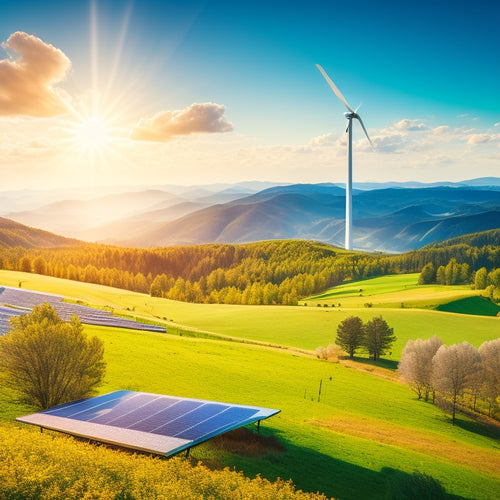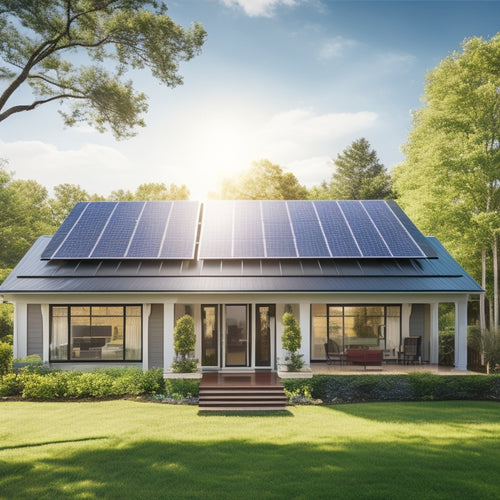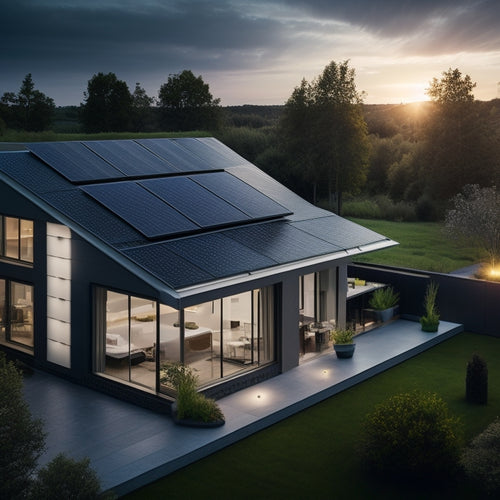
Disadvantages of Metal Roofing Materials
Share
When considering metal roofing materials, be aware of several disadvantages. They can suffer from impact resistance limitations, particularly in extreme weather. Thermal expansion may cause gaps and misalignments, leading to moisture infiltration. Additionally, high humidity increases the risk of corrosion unless you select appropriately engineered materials. Aesthetically, choices in color and design can be limited, potentially clashing with your home's style. Finally, while initial costs are higher than asphalt shingles, the long-term savings might not justify the upfront investment for everyone. Understanding these factors is essential for an informed decision about your roofing options. More perspectives are ahead.
At a Glance
- Metal roofs may have limited impact resistance, especially with thinner materials, leading to dents and aesthetic issues during severe weather.
- Thermal expansion can cause gaps and misalignments in metal roofs, increasing the risk of water infiltration and structural damage.
- High humidity can lead to corrosion, making material selection and protective coatings critical for longevity in humid climates.
- Energy efficiency can be compromised without adequate insulation, leading to higher indoor temperatures and increased energy costs.
- A limited range of colors and styles may restrict design options, potentially clashing with certain architectural aesthetics.
Durability Against Extreme Weather
When considering metal roofing for areas prone to extreme weather, it's essential to understand its impact resistance limitations. While metal roofs can withstand certain conditions, they may not hold up against severe hail or flying debris.
In addition, thermal expansion can lead to structural issues over time, particularly in regions with significant temperature fluctuations. However, the durability of metal roofs can be enhanced by their ability to withstand high winds and heavy rainfall, which are common in many storm-prone areas, making them a popular choice for homeowners seeking long-term solutions.
Moreover, the durable materials used in metal roofing can contribute to lower maintenance costs in the long run.
Impact Resistance Limitations
Facing extreme weather events, homeowners often choose metal roofing for its durability and longevity. However, it's essential to recognize the impact resistance limitations of these materials. While metal roofs employ various impact absorption techniques, they can still fall short during severe conditions, such as hailstorms or flying debris from high winds.
Metal roofing systems usually feature dent resistance materials designed to withstand moderate impacts. Yet, the effectiveness can vary considerably depending on the thickness and quality of the metal used. Thinner materials may dent more easily, compromising the aesthetic and functional integrity of your roof.
Here's a quick comparison of common metal roofing materials and their impact resistance:
| Material Type | Impact Resistance Level |
|---|---|
| Aluminum | Moderate |
| Steel (Galvanized) | High |
| Copper | Moderate to High |
| Zinc | Moderate |
Understanding these limitations can help you make informed decisions about the best roofing material for your home, ensuring you balance durability with your specific environmental challenges. Always consider the potential risks in your area before committing to a metal roofing choice.
Thermal Expansion Concerns
How does thermal expansion affect the durability of metal roofing in extreme weather? When temperatures fluctuate, metal roofing expands and contracts, leading to thermal expansion effects that can compromise your roof's integrity. This movement can create gaps, misalignments, and, over time, may contribute to metal fatigue concerns. If not addressed, these issues can result in leaks and structural deficiencies.
In extreme weather conditions, the impact of thermal expansion becomes even more pronounced. For instance, during scorching heat, the metal may expand considerably, while freezing temperatures can cause it to contract rapidly. This cycle can exacerbate wear and tear, especially if the roofing system isn't designed to accommodate such movements.
Moreover, the fasteners and seams used in metal roofing may loosen or degrade due to constant expansion and contraction, increasing the risk of water infiltration.
To reduce these risks, you'll want to confirm proper installation with flexible materials that allow for movement. Choosing high-quality metal roofing that incorporates thermal movement solutions can help enhance durability and longevity, safeguarding your investment against the challenges posed by extreme weather.
Energy Efficiency Advantages
Metal roofing materials offer significant energy efficiency advantages due to their reflective properties, which help reduce heat absorption.
This can lead to lower cooling costs during hot months, as your home stays cooler.
Moreover, effective temperature regulation enhances overall energy performance, making metal roofs a smart choice for energy-conscious homeowners.
In addition, integrating solar panels with metal roofs can maximize energy harvesting methods and additionally promote sustainability.
Reflective Properties Benefits
The reflective properties of metal roofing materials greatly enhance energy efficiency in residential and commercial buildings. When you choose metal roofing with reflective coatings, you're greatly reducing sunlight absorption. This means less heat gets absorbed into your structure, allowing for a cooler interior environment.
By minimizing the need for artificial cooling methods, you can lower your energy bills and reduce your carbon footprint. Metal roofs can reflect up to 70% of the sun's rays, depending on the specific coatings used. This not only helps in maintaining comfort within your space but also contributes to extending the lifespan of your roofing materials, as excessive heat can lead to deterioration over time.
Additionally, the use of reflective coatings can qualify you for energy efficiency tax credits or rebates, making it an economically sound choice. Investing in metal roofing with these reflective properties enables you to create a more sustainable living or working environment.
Temperature Regulation Impact
When it comes to energy efficiency, temperature regulation plays an important role in maintaining comfortable indoor environments.
Metal roofing materials, while reflecting heat effectively, can also impact your home's insulation performance. One significant factor to evaluate is heat absorption. On sunny days, metal roofs can absorb a considerable amount of heat, which may lead to increased indoor temperatures. This could force your cooling systems to work harder, raising your energy bills.
Moreover, the insulation performance of your roofing system is vital. A metal roof's inherent properties may not provide the same level of insulation as other materials, potentially leading to greater heat transfer. Without adequate insulation, the benefits of your roof's reflective properties can be diminished.
You'll want to weigh these temperature regulation impacts carefully against the advantages of metal roofing. While they can offer durability and longevity, the energy efficiency drawbacks related to heat absorption and insulation performance may affect your overall comfort and costs.
Ultimately, evaluating local climate and personal comfort preferences will help you make a more informed decision about your roofing material.
Design Options Available
When considering metal roofing, you'll find that design options can be somewhat limited. Many metal roofs come in a narrow range of colors, which may not suit every aesthetic preference.
Additionally, certain styles may not harmonize well with specific structural designs, potentially impacting your home's overall appearance.
However, advancements in manufacturing processes are continuously improving the variety of available designs and colors, making it easier to find a suitable option for your home.
As a result of increased competition in the market, consumers may soon see a wider range of choices in metal roofing materials, enhancing their overall appeal and functionality.
lower production costs may also contribute to more diverse design selections in the future.
Limited Color Choices
Choosing metal roofing materials can limit your design options due to a narrower palette of available colors compared to other roofing types. While metal roofing offers durability and longevity, the color selections often fall short, presenting aesthetic limitations that may not align with your vision.
Many metal roofing manufacturers provide a limited range of standard colors, which mightn't suit every design style or personal preference. If you desire lively hues or unique shades, you might find yourself constrained.
Additionally, some metal roofing colors are prone to color fading over time, which can detract from your home's overall appearance. This color fading can occur due to prolonged exposure to UV rays, weather conditions, and environmental factors.
Even when you initially choose a color that appeals to you, the longevity of that color may not match your expectations. If you're focused on achieving a specific look, the restricted color options of metal roofing can be frustrating.
Exploring alternatives or custom finishes could be necessary, but those choices often come with increased costs and longer lead times. Ultimately, carefully consider whether the durability of metal roofing outweighs the potential limitations in color selection.
Style Compatibility Issues
Over time, homeowners may encounter style compatibility issues when selecting metal roofing materials. While metal roofs offer durability and longevity, they often struggle to align with your aesthetic preferences and the design harmony of your home. The sleek, modern look of some metal roofing options may clash with traditional or rustic styles, creating visual discord.
To help you maneuver through these challenges, consider the following table that outlines common roofing styles and their compatibility with metal roofing materials:
| Roofing Style | Compatibility | Aesthetic Considerations |
|---|---|---|
| Modern | High | Sleek, minimalist design |
| Traditional | Medium | May require added accents |
| Rustic | Low | Clashes with natural textures |
| Mediterranean | Medium | Needs careful color choice |
| Industrial | High | Complements raw materials |
Choosing the right metal roofing requires thoughtful consideration of your home's overall design. If you prioritize design harmony, you may want to investigate various materials or finishes that better align with your style preferences. Ultimately, a well-coordinated look can enhance your home's appeal and value.
Selecting Based on Climate Conditions
When selecting metal roofing materials, you need to take into account your local climate conditions.
Temperature extremes can greatly impact the performance of your roof, affecting its durability and longevity. For instance, solar panel durability is influenced by environmental factors, which can similarly apply to roofing materials.
Additionally, high humidity levels can increase the risk of corrosion, making it essential to choose materials suited for your environment.
Temperature Extremes Impact Performance
In regions experiencing extreme temperature fluctuations, the performance of metal roofing materials can considerably vary. These materials often exhibit high thermal conductivity effects, meaning they can absorb and retain heat, which mightn't align with your insulation requirements.
During scorching summers, metal roofs can heat up quickly, increasing the internal temperature of your home. Conversely, in frigid winters, they can lose heat rapidly, leading to potential cold drafts inside.
If you're considering metal roofing, it's essential to account for your local climate. In areas with significant temperature swings, you may need to invest in additional insulation to maintain a comfortable indoor environment. Proper insulation can mitigate the thermal conductivity effects of metal, ensuring that your heating and cooling systems operate efficiently.
Moreover, the expansion and contraction of metal due to temperature changes can lead to structural issues, including warping or buckling over time. This means that while metal roofing offers durability, its performance is contingent upon how well it's suited to your climate.
Ultimately, by evaluating these factors, you can make an informed decision about whether metal roofing is the right choice for your home.
Humidity and Corrosion Risks
Humidity can greatly impact the longevity and performance of metal roofing materials, particularly in regions with high moisture levels. If you live in such an area, you'll need to prioritize humidity control to mitigate potential corrosion risks.
Metal roofing is often susceptible to rust and degradation when exposed to prolonged moisture, which can lead to premature failure. To enhance corrosion prevention, consider selecting roofing materials specifically engineered for humid climates.
Coatings such as galvanized steel or aluminum with protective finishes can offer better resistance against the effects of moisture. Additionally, guarantee proper ventilation in your roofing system; this helps reduce humidity buildup beneath the roof and minimizes the risk of corrosion.
Regular maintenance is also essential. Inspect your roof for any signs of corrosion or wear and tear, and address any issues immediately.
By being proactive about humidity control and corrosion prevention, you can considerably extend the lifespan of your metal roof, giving you the freedom to enjoy your investment without constant worry.
Ultimately, understanding the relationship between humidity and roofing materials will enable you to make informed choices based on your specific climate conditions.
Longer Lifespan Than Shingles
While metal roofing materials can last considerably longer than traditional shingles, this longevity comes with higher initial costs.
You'll need to weigh the upfront investment against the potential savings from reduced replacement and repair expenses over time.
Understanding these financial implications is essential for making an informed roofing decision.
Initial Cost Considerations
Many homeowners are surprised to learn that the initial cost of metal roofing materials can be considerably higher than traditional asphalt shingles. While metal roofs offer a longer lifespan, the upfront investment can be intimidating. You'll need to evaluate financing options and installation costs when making your decision.
Here's a breakdown to help you visualize the cost differences:
| Roofing Material | Average Cost per Square Foot | Lifespan (Years) | Installation Costs |
|---|---|---|---|
| Asphalt Shingles | $3 - $5 | 15 - 30 | $1,500 - $2,500 |
| Metal Roofing | $7 - $12 | 40 - 70 | $2,000 - $4,000 |
As you can see, while the installation costs and initial price for metal roofing are higher, its longevity could ultimately save you money in the long run. It's important to weigh these initial costs against the potential benefits of reduced maintenance and replacement frequency. Reflect on your financial situation and whether financing options align with your budget before making a final decision.
Frequently Asked Questions
How Do Metal Roofs Perform in Hail Storms?
Metal roofs excel during hail storms due to their durability, often resisting hail damage better than traditional materials. You'll appreciate their longevity and low maintenance, ensuring your investment withstands the test of severe weather conditions.
What Maintenance Is Required for Metal Roofing?
You'll need to check for rust prevention regularly and guarantee proper insulation considerations. Cleaning debris, inspecting seams, and addressing any issues promptly will help maintain your metal roof's integrity and longevity, providing you with peace of mind.
Are Metal Roofs Noisy During Rain or Hail?
You might think a metal roof's like a drum, amplifying rain's sweet serenade. However, with proper insulation and rain soundproofing, you won't hear much noise. Enjoy peace while nature performs its orchestration above you!
Can Metal Roofing Be Installed Over Existing Shingles?
Yes, you can install metal roofing over existing shingles, but be aware of installation challenges and weight considerations. Ensuring your roof structure can support the added weight is essential for a successful and safe installation.
How Does Metal Roofing Affect Home Resale Value?
Metal roofing markedly enhances your home's resale value. Its energy efficiency raises appeal, while potential insurance savings sweeten the deal. Savvy buyers seek sustainable options, making your property more desirable in today's eco-conscious market.
Explore More
Ultimately, while metal roofing offers notable benefits like durability and energy efficiency, it's crucial to take into account its disadvantages. For instance, metal roofs can cost 10-20% more upfront than asphalt shingles, which can be a significant factor for budget-conscious homeowners. Additionally, their susceptibility to denting from hail can be a concern in certain regions. By evaluating these factors against your specific needs, you can make a more informed decision for your roofing project.
Related Posts
-

Renewable Energy Solutions to Reduce Your Carbon Footprint
To reduce your carbon footprint, adopting renewable energy solutions is key. Using solar panels or wind turbines can ...
-

Home Solar Installation Cost
You're considering installing solar panels on your home, and the upfront cost is likely the biggest hurdle standing i...
-

Home Solar Battery
You're opting for a home solar battery that allows you to utilize the power of the sun during the day and use it at n...


